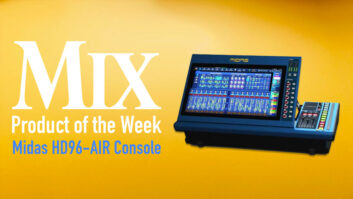The folks at Behringer have introduced a new digital mixing console called the Wing, a 48-channel, 28-bus desk with 24 motorized, 100mm faders. Onboard analog I/O includes eight Midas PRO mic preamps and eight XLR outputs, plus eight aux inputs and eight aux outputs on TRS connectors. Digital connectivity includes three AES50, AES/EBU, and StageCon, combining for a total of 144 channels of I/O; the AES50 ports feature Klark-Teknik’s SuperMAC technology for ultra-low jitter and latency.

The Wing’s architecture is organized into sources and channels. A source is any incoming signal, whether from an analog or digital input, internal effect, USB port, stage box or expansion card. Sources are routed to channels, and a channel can have a Main source and an Alternative source (the ability to route from an alternative source facilitates virtual soundchecks).
Any of the Wing’s 48 input channels or 28 output buses can be configured for mono, stereo or mid-side operation, without need to reboot the desk. When a stereo source is assigned to a channel, that channel is automatically configured as stereo, and offers control over stereo width ranging from 150% stereo to mono. Each input channel has three filters (LPF, HPF and Tilt), 6-band EQ consisting of high- and low-shelf, plus four parametric bands, gate with key filter, compressor (with an assortment of models), and pre- and post-fader inserts.

Output channels include four main buses, eight matrix and 16 stereo aux buses, each providing dual inserts, 8-band parametric EQ, a stereo imager, and full dynamics processing. The main buses can be configured as mono, stereo or mid-side compatible.
Read more Product of the Week: Appsys Pro Audio MVR-64 Multiverter.
Beneath the Wing’s 10-inch pivoting touchscreen are six touch-sensitive soft knobs used to control console parameters. In addition, a dedicated channel strip section provides instant access to all channel controls via touch-sensitive knobs, with dedicated knobs for EQ. Individual bands of the parametric EQ may be solo’d, enabling a user to isolate the action of each EQ band. In addition to the Wing’s standard EQ, six additional types of EQ are available, including SSL, Pultec, and Focusrite emulations.
A variety of onboard effects processors can be configured using aux send-return, or used as pre- or post-fader channel inserts. These effects include reverbs, delays, phase shift, tape emulation, pitch correction, amp simulation and a wide range of modulation effects. Several “Premium” effects are also provided; these use more DSP resources but offer more features and higher-quality sound.
The Wing’s rear-panel USB port enables the desk to be used as a 48×48 interface for DAW recording and playback. A pair of SD card slots support recording of 32 tracks (per card) with a sync option for 64-track recording. It is also possible to use one SD card for recording while the other is simultaneously used for playback.
Optional connectivity modules are available for 64×64 channels of audio over Ethernet supporting Waves SoundGrid, Dante or AES67 formats. A StageCon port can be used to route 32 channels of audio I/O, and a MADI expansion card is planned for the future.
Street price for the Wing is around $3500.
More info here.







